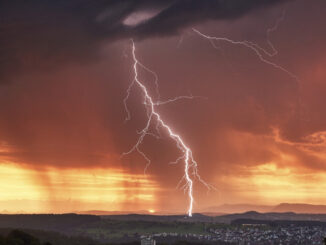
If you’ve been following along (well done you!) then you might recall that we need a fast switch that works at a very high voltage for the laser’s pump lamp and, indeed, for the laser to work at all. The above photo shows the little guy that makes it all possible.
The atmosphere that we all live in is mainly made up of nitrogen (or CO2, if you work for the government/MSM!) and, obviously, it doesn’t conduct electricity very easily. But by applying a high enough voltage to it (like the xenon gas in the flash tube) it will conduct really well, in fact nearly as good as metal (an ohm or less). If we take an average break down (conduction) of thirty thousand volts per centimetre (depends on your altitude, but this is not a bad estimate) then a three to four millimetre gap should be a conduction point of about ten thousand volts.
The spark gap that I’ve made is adjustable from zero to about five millimetres. It’s a noisy little git – makes quite a loud ‘crack’ when it ignites. I’ve therefore sealed it in a plastic tube with a small clear window for observation.
Now, For Something Completely Different…

For completeness I need to describe the above circuit without putting too many readers off!. It’s similar to a single stage from a Marx Generator. I was trying to think of a fun analogy for this and my mind (once again) went back to toys from Christmases past.
Good Old Evel Knievel
A cousin had an ‘Evel Knievel stunt bike’ back in the early eighties. It consisted of a small plastic bike with a crude representation of Evel sitting on it. The rear wheel was a heavy flywheel (CF). You placed the little bike on a sort of plastic base with a handle and wound the thing up until it spun really fast (10KV power supply). Once up to speed you’d release the bike and it would shoot off towards a ramp (SG) and end up smashing into a wall or skirting board, usually chipping the paint (worse, breaking a ceramic ornament) and all hell would break loose with parents shouting at you (FL). Great times.
Technically, ‘CF’ is the main storage capacitor (or flywheel) and needs to be between sixteen and twenty four nanofarads – we need speed. ‘FL’ and ‘SG’ are the flash tube and spark gap. ‘CP’ is the “peaking capacitor” and simply ‘smooths’ the action of the arc/switch – about a nanofarad. ‘RC’ completes the circuit; I’ve chosen a value of around four kilo-ohms.
There Will Be Light (And Lots Of It!)
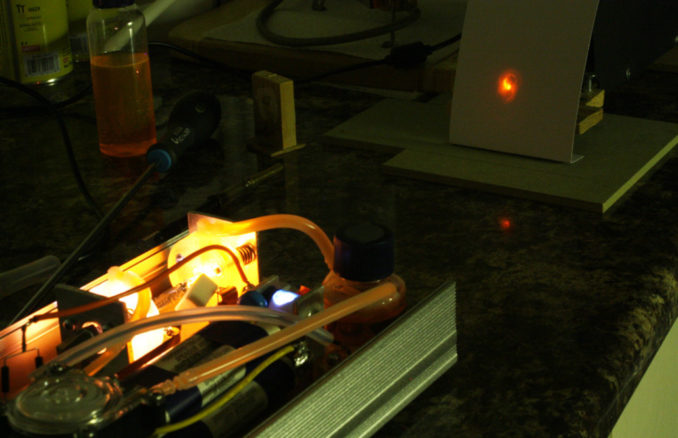
The one thing that I could not show you with my ruby laser project is what happens between the two mirrors when it’s lasing – my poor camera would have probably exploded! In this photo you can see raw quantum mechanics in action. A brilliant yellow light as the electrons are stimulated back to their ground state. It overpowers the xenon flash tube’s white light quite easily. Mirrors and electrons = pure magic.
Another thing to note is the rather beautiful ‘spiral galaxy’ laser spot. Visually lovely, though it may be, quality LASER optical it’s not.
The Peristaltic Pump
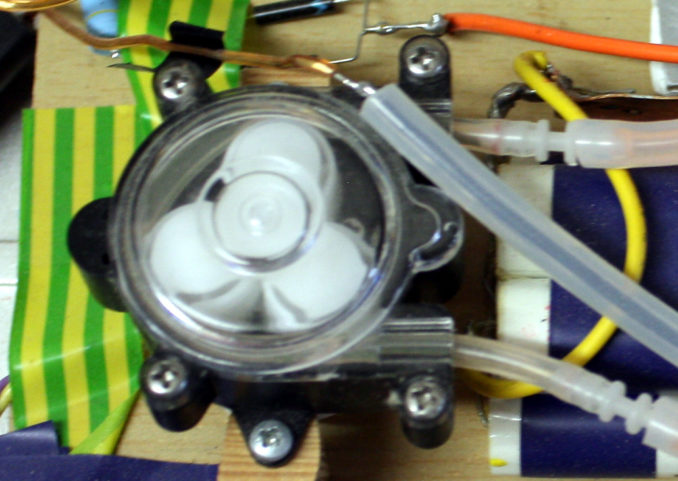
This pump has two uses. One I mentioned before and that is to fill/empty the laser cell. The other can be shown with this photo:
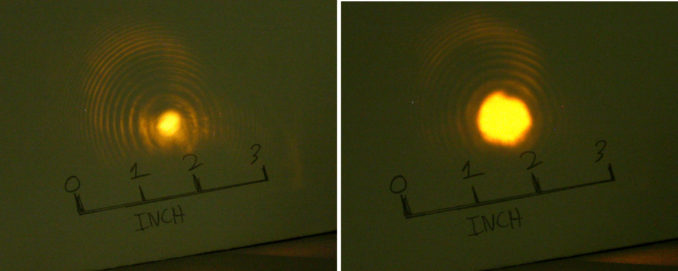
As I wrote in part one, dye lasers are just..err..a problem. Fast and with a wide bandwidth – great! Optically making and tuning them – yuk! You are not going to be able to watch your “classic hard core porn of the 1970s” DVD collection, that you recently transferred from Betamax, with this thing. (Not that I’d know anything about such things. *cough*)
The beam quality is poor and that is a general property of dye lasers. In the above photo you’ll notice that there is no “laser speckle”. The light has a very broad bandwidth. But the biggest difference is between the size of the spot on the left compared to the one on the right. When the xenon flash tube conducts it generates not only light but also heat. Even the tiniest temperature change inside of the R6G dye cell will cause this ‘thermal-optical’ distortion. There are a few seconds between each laser pulse but the effect is quite noticeable.
Using the peristaltic pump to put ‘fresh’ R6G dye into the laser cell (between laser pulses) helps to reduce this problem. It’s not perfect but as I have written: dye lasers are a…you get the idea.
Improving On The Laser Beam’s Divergence
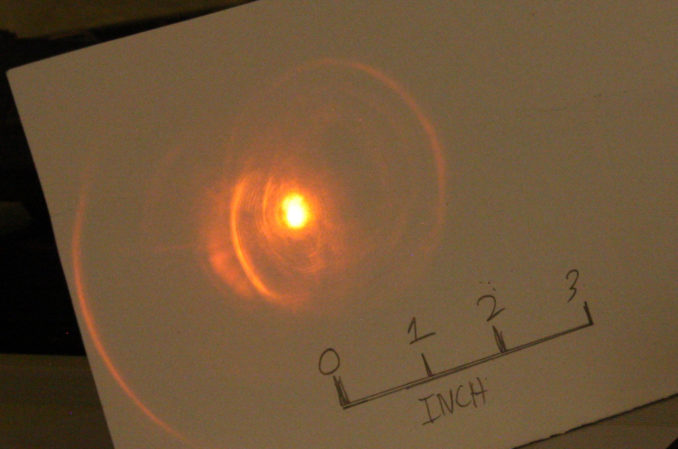
You perhaps own a little battery powered laser pointer. What few people realise is that the laser light from the semiconductor diode is extremely divergent – imagine a cone shaped light source. It does not form the nice thin beam of light that you usually associate with a laser. To turn that light into a ‘laser beam’ requires the use of a ‘collimator’.
It’s simply a telescope (or telephoto lens) with the light shinning in through the eyepiece. This makes the light rays ‘more parallel’ and, therefore, reduces their divergence. In the above photo I’ve made a simple two element collimator (not shown). Easy to see that it has made the spot size a lot smaller over the same distance – also, there’s some nice lens flare!
The Raw Laser Beam
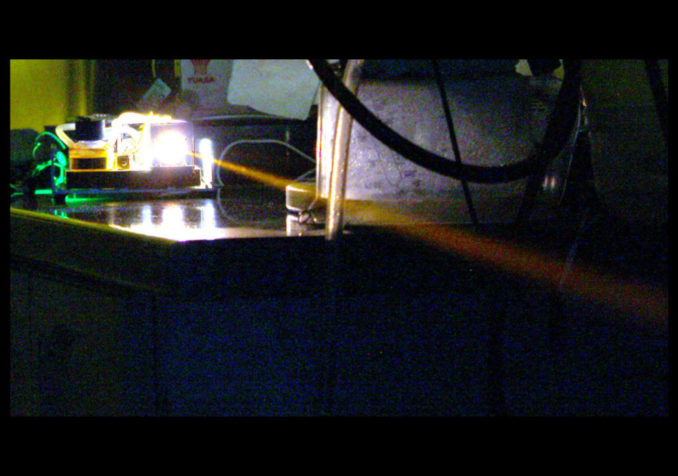
Conclusion
A relatively simple project that demonstrates a narrow bore xenon flash tube can pump rhodamine 6G dye to its lasing threshold. Don’t expect this little laser to burn or cut any material. Having written that, if we assume that the laser delivers, say, just fifty (50) micro joules (watt/second) with a lasing time of one hundred nanoseconds – that would be an equivalent energy pulse of about five hundred (500) watts! Impressive for such a tiny laser.
Quite difficult to engineer , as it’s a liquid laser, but fairly cheap to build. Even though it’s only low power (at this scale) it’s nonetheless satisfying to make it work.
© text & images Doc Mike Finnley 2021
The Goodnight Vienna Audio file
Audio Player


 In part two we looked at how a
In part two we looked at how a 